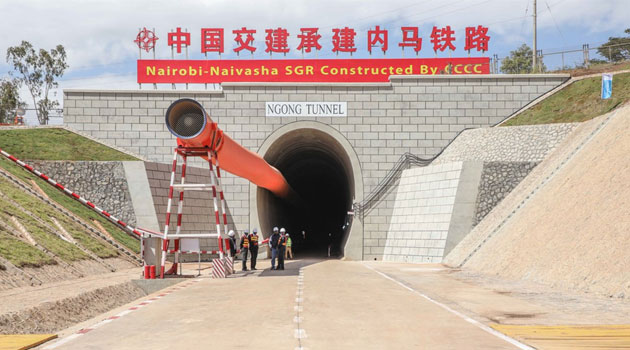
The SGR Phase 2 includes drilling the longest railway tunnel in Kenya (4.5 km) at Embulbul in Kajiado County. The tunnel is also the 2nd longest railway tunnel in Africa./FILE
NAIROBI, Kenya Dec 24 – The successful completion of the Nairobi-Naivasha Standard Gauge Railway (SGR) project risks overshooting its 2019 Madaraka Day deadline due to the current compensation stalemate in some sections.
China Communications Construction Company (CCCC), the firm building the 120-kilometre SGR Phase 2A which also includes supporting infrastructure, roadbeds, culverts, bridges and station buildings, said the project is 80 percent complete.
However, the compensation disputes in areas including the Nairobi National Park and Embulbul, Ngong, might delay the project.
“Before work was stopped in July 2018, the anticipated completion day was June 2019 and with the remaining section of work not being attended to, the launch date may be delayed,” said Steve Zhao, CCCC Kenya Spokesman.
“We are however hopeful that once the issues are resolved and CCCC resumes work, we will be able to work hard as expected and deliver exemplary results as is our norm.”
Zhao pointed out that the contractor is working closely with Kenya Railway Corporation (KRC) and National Lands Commission (NLC) to speed up the compensation process to the affected landowners so that work can resume.
Despite the land compensation challenges, this year CCCC has achieved some notable milestones including drilling the longest railway tunnel in Kenya (4.5 km) at Embulbul in Kajiado County. The tunnel is also the 2nd longest railway tunnel in Africa.
Another major milestone is the construction of one of the tallest bridges in Kenya – the Murua Olkondi Super Major Bridge in Duka Moja, Narok County, with its tallest pillar standing at a height of 46 meters. The contractor used the hanging basket construction technique, a first in the country, to overcome the geographical challenges of constructing over a valley.
According to Zhao, at the beginning of this year, the SGR Phase 2A Contractor, initially employed 13,482 Kenyans and 2148 Chinese personnel for the construction of the 120km Nairobi – Naivasha SGR line.
However, as the construction works were stopped and some sections completed their portions of construction; only less than 6000 employees including 958 Chinese employees are still actively engaged in the final phases of the project.
“Please note that in areas where work was halted temporarily, all employees in those areas were sent home awaiting the resumption of works at a later date,” explained Zhao.
The impact of the SGR Phase 2A has also been extended to local suppliers, where procurement of goods such as cement, steel, oil, as well as transport services has increased significantly.
“We are currently sourcing 100pc of the high-strength 52.5 cement locally, from manufacturers like Bamburi cement, ARM Cement, East African Portland Cement, and Savannah Cement. The procurement of reinforcing bar – rebar – is also being sourced locally from Devki Steel Mills and Apex Steel among others,” said Zhao.
The 120km line is the first of the three segments that make up the second phase of the SGR construction that is expected to terminate at Malaba. Phase 2A to Naivasha will pass through the five counties of Nairobi, Kajiado, Kiambu, Nakuru and Narok.
It will feature five newly-built stations at Ongata Rongai, Ngong, Mai Mahiu, Suswa and Nachu. There are 27 bridges, which are 17.3 km in length and three tunnels, which are 7.148 km long. The total length of bridges and tunnels is 24.448 km, accounting for 20.4pc of the route length.
SGR Phase 2A, starts from Syokimau and ends in Mai Mahiu, where a station will be built.








































